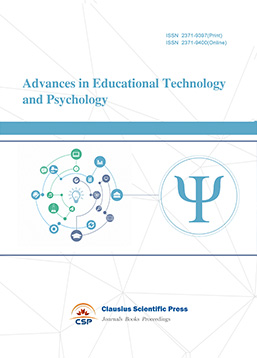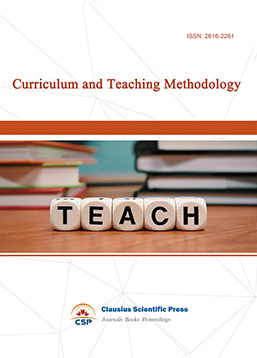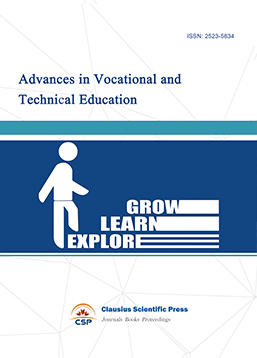Establishment of a Risk Perception Scenario Library for Nursing Staff and Assessment of the Reliability and Validity of Its Images
DOI: 10.23977/appep.2025.060320 | Downloads: 7 | Views: 142
Author(s)
Siwen Li 1, Wei Dong 2, Tianya Hou 2, Zongwang Huang 1, Zanhui Xu 1
Affiliation(s)
1 School of Health Science and Engineering, University of Shanghai for Science and Technology, Shanghai, 200093, China
2 Department of Naval Aviation & Operational Psychology, Faculty of Psychology, Naval Medical University, Shanghai, 200433, China
Corresponding Author
Wei DongABSTRACT
To preliminarily establish a risk perception scenario library for nursing staff and test its reliability and validity, so as to provide reliable training materials for subsequent risk perception regulation training of nursing staff. This study took thirty-six nursing staff screened out pictures from 196 pictures. The pictures with a dimension recognition degree of more than 80% and an average score of the perceived risk intensity greater than 4 points were selected. Eleven experts carried out two rounds of screening, scoring the pictures in terms of the degree of dimension matching, the perceived risk intensity, and whether they could be included in the risk perception scenario library. Finally, the reliability and validity of the pictures were evaluated. As shown in the results,thirty-one pictures were screened out to form the risk perception scenario library for nursing staff. The Cronbach’sα coefficients of the pictures in terms of pleasantness, threat level, and arousal level were 0.995, 0.991, and 0.987 respectively; the content validity index of the pictures was 0.886,and the test-retest reliability was 0.760 and the split-half reliability was 0.900; there was a negative correlation between the ratings of pleasantness and threat level in the picture library (r = -0.32, P < 0.001); a positive correlation between arousal level and threat level in the picture library (r=0.65, P<0.001).the scatter plot showed that when the rating of pleasantness was low, the rating of threat level was at a high level, and when the rating of pleasantness was high, the rating of threat level would decrease accordingly and the higher the threat level score, the higher the arousal level score of the pictures.The results of the study prove that the preliminary evaluation of the risk perception scenario library for nursing staff is good, which can provide reliable materials for subsequent risk perception regulation training of nursing staff.
KEYWORDS
Nursing Staff; Risk Perception; Scenario Library; Pleasantness; Arousal Level; Threat Level; Reliability; ValidityCITE THIS PAPER
Siwen Li, Wei Dong, Tianya Hou, Zongwang Huang, Zanhui Xu, Establishment of a Risk Perception Scenario Library for Nursing Staff and Assessment of the Reliability and Validity of Its Images. Applied & Educational Psychology (2025) Vol. 6: 151-161. DOI: http://dx.doi.org/10.23977/appep.2025.060320.
REFERENCES
[1] Paul S, Ellen P,L M F, et al. Affect, risk, and decision making.[J].Health psychology : official journal of the Division of Health Psychology, American Psychological Association,2005,24(4S):S35-40.
[2] Hu Yanning. Thinking on nursing professional risk management education [J]. China Nursing Education, 2015, 12 (01): 79-80.
[3] Negreli A S, Juliano R O, Roberto L P, et al. Biomonitoring of pharmacists and nurses at occupational risk from handling antineoplastic agents.[J].The International journal of pharmacy practice,2019,28(5):506-511.
[4] Pamela T, Angela G, Donna M, et al. Nursing perception of risk in common nursing practice situations.[J].Journal of healthcare risk management : the journal of the American Society for Healthcare Risk Management,2018,37(3):19-28.
[5] Zhang Boming, Wang Yanhua, Liang Mingming, et al. Effect of COVID-19 risk perception on anxiety: a mediated mediation model [J]. Chinese Journal of Clinical Psychology, 2023, 31 (01): 213-217.
[6] Ji Yan, Sun Hongyu, Xu Xianxian, et al. Construction of public risk perception and emotional guidance intervention program for major public health emergency [J]. Nursing Research, 2023, 37 (16): 2903-2908.
[7] Kvamme L T, Pedersen U M, Overgaard M, et al. Pilot study: Improving attention bias modification of alcohol cues through concealed gaze-contingent feedback in alcohol dependence[J].Addictive Behaviors Reports,2019,10100231.
[8] Li Xin, Zhong Hui, Mo Daming, et al. Intervention trial of attentional bias correction training on adolescent anxiety disorder [J]. Chinese Journal of Mental Health, 2021, 35 (10): 826-831.
[9] Xiao Danhe, Li Jun, Ge Cao, et al. Study on Emotional Attentional Bias and Intervention of Attentional Bias Training of Internet Bullied Individuals [J]. Psychology and Behavior Research, 2022, 20 (06): 828-834.
[10] Zhao Xin, Zhang Peng, Chen Ling. Intervention of Attentional Bias Training on Social Anxiety: Methods, Effects and Mechanisms [J]. Advances in Psychological Science, 2014, 22 (08): 1246-1257.
[11] Huang Siyuan, Zhang Yingjun, Yao Shisha, et al. Attentional bias correction training for social anxiety of college students [J]. Chinese Journal of Clinical Psychology, 2017,25 (05): 986-990 + 927.
[12] Dong-Ni P, Yi W, Zheng L, et al. The altered early components and the decisive later process underlying attention bias modification in social anxiety: evidence from event-related potentials.[J].Social cognitive and affective neuroscience,2019,14(12):1307-1316.
[13] Chen Jing, Gao Lei, Li Tianzhi. Randomized controlled trial of attentional bias training for mobile phone addiction in college students [J]. Chinese Journal of Mental Health, 2022, 36 (09): 799-804.
[14] Tang Hao, Zhao Hengwei, Wang Wei. Attentional bias of drug addicts and application of attentional bias training in addictive behavior [J]. Chinese Journal of Drug Dependence, 2015, 24 (03): 175-179 + 186.
[15] Shen H, Zhu WL, Wu XM, et al. Effects of different cognitive bias training on attentional bias and relapse rate in male alcohol dependent patients after abstinence treatment [J]. Journal of Clinical Psychiatry, 2021, 31 (06): 449-452.
[16] B W M Z,Sandor H,B S A, et al.Gamified M-Health Attention Bias Modification Intervention for Individuals with Opioid Use Disorder: Protocol for a Pilot Randomised Study.[J].International journal of environmental research and public health,2020,17(3):752.
[17] Shao Xiaoqin, Yin Qianlan, Song Xiangrui, et al. Structure validation and evaluation of risk perception questionnaire for nursing staff based on network analysis [J]. Military Nursing, 2024, 41 (09): 33-37.
[18] Yair B, Dominique L,Lee P, et al. Threat-related attentional bias in anxious and nonanxious individuals: a meta-analytic study.[J].Psychological bulletin,2007,133(1):1-24.
[19] Zhang Xinwei. Study on the development and influencing factors of risk perception questionnaire for nursing staff [D]. Fourth Military Medical University, 2016.
[20] S B M. Physiology and neurobiology of stress and adaptation: central role of the brain.[J].Physiological reviews,2007,87(3):873-904.
[21] West Charles K., Berlyne D. E.,. Aesthetics and Psychobiology[J]. Journal of Aesthetic Education, 1978, 12(3): 117-122.
[22] X. L B.The Emotional Brain: The Mysterious Underpinnings of Emotional Life. Joseph LeDoux[J].The Quarterly Review of Biology,1999,74(4):487-489.
[23] Gao J, Wang ZW, Cai Z, et al. Establishment of attentional bias training picture library for alcohol dependence patients and evaluation of reliability and validity of the pictures [J].Journal of Nursing Research, 2021, 35 (12): 2184-2189.
[24] Aycock M D, Clark C P, Araya S. Measurement and Outcomes of the Perceived Risk of Stroke: A Review[J]. Western Journal of Nursing Research,2019,41(1):134-154.
| Downloads: | 17719 |
|---|---|
| Visits: | 651844 |

 Download as PDF
Download as PDF



